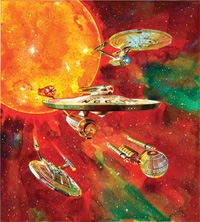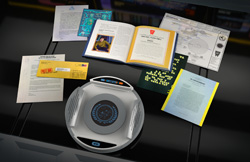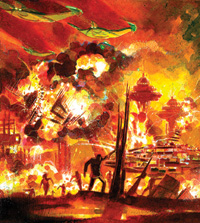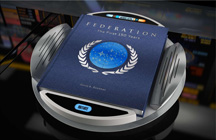 |
||||||||
Book: Star Trek Federation: David Goodman Interview 1 |
||||||||
|
 |
Star Trek Federation: The First 150 Years - David Goodman Interview 1
Posted on November 19, 2012 • Trek Merchandise
To celebrate the launch, we spoke with the author himself, David Goodman in an exclusive in-depth interview! Part 1 of the interview is shown below:
TrekCore: What were your thoughts when David Rossi first mentioned the Star Trek Federation project to you? David Goodman: Well my thought was ‘Why are they calling me?!’. I mean, I’ve never written a book before and I felt like there had to be a whole list of people that they would have tried before calling me. I was excited but also very nervous that at some point somebody would say “Oh, he’s never written a book! Who said he could write this book?!” But nobody ever said that. I guess the only one who questioned whether or not I should write it was me. Which I’m still questioning! But I was very excited… immediately in my mind there were so many things in the Star Trek history that I’d like to write about. TrekCore: How much of a leap was it for you going from television script writing to authoring a book of this magnitude? David Goodman: It was interesting because TV writing is a collaborative effort in so many ways, you are always working with a group of people before you go off to write a script. You’re figuring out the story, and comedy where I mostly work you’re figuring out jokes. So by the time you write a script you’ve sort of had a lot of help. There was a similarity to writing this book, because there was a way in which all the Star Trek writers who had come before me had come up with stuff that I wanted to include but also had to include. So when I went off to write the book, I had all this material to work from, but also had to create a fair amount.
David Goodman: There were a couple of times, and I had my own sort of mini-tribunal. There was a guy [John Van Citters] who worked at CBS Consumer Products and was also a big Star Trek fan, and then Dave Rossi and Mike Sussman – who I worked with on Enterprise and is a good friend. I ran a few things past them, and when I had a question about something… I would come up with something and wasn’t sure if it contradicted canon, so I would run it past them and they would either give me the go-ahead or say “No, you have to do this.” But that was only a couple of times, for most of it, I sort of figured it out on my own. TrekCore: You mention canon there. How much of a hindrance or an aid was canon to you? Star Trek has such a rich and varied history – it must have proven a minefield at some times! David Goodman: Yeah, ‘minefield’ is a great term for it… especially since the ‘Minefield’ episode of Enterprise caused me all sorts of problems for the canon! It was a puzzle. I was basically putting together this puzzle because it was so important to me as a fan that if I was reading this book, I wouldn’t read something that would bug me because it so blatantly contradicted something that I remembered from an episode. I was very much driven to write something that obeyed everything that had come before me, but also stood on its own. I had to create scenes and pieces of history that had not been fully elucidated in the Star Trek TV shows and movies but that didn’t contradict them either. So canon wasn’t a hindrance… in fact canon was fun to work in. However there was just this feeling of times where… you know, for example during the Romulan War you have to obey the fact that no human had ever seen a Romulan. So when you’re doing the Romulan War you have to say ‘OK, so that means there were no troops on planets’ because there would be a dead Romulan body left somewhere that someone would find. So then it would be a war that takes place entirely in space. There are all these sorts of things that you have to obey that don’t necessarily make sense if you were doing it the other way round, for instance if you’re doing a war between Humans and Romulans you would do troops, you would do landing on the planets and all this sort of thing. But I just didn’t think that was realistic given what we knew about that war. So that’s just an example of where canon was a hindrance, but I just sort of worked it out in such a way that it doesn’t read like one. TrekCore: I find it interesting that whole sections of this book sometimes originate from what maybe just a throwaway line in an episode years ago. I find that amazing! What inspired you in choosing which stories to tell? David Goodman: (laughter) Well, I’m writing a history book. I’m writing a History of the Federation. So, for example – Tarsus IV – which is this event that is described in ‘The Conscience of the King’, an Original Series episode. It’s one episode of the Original Series, it’s not necessarily considered one of the best episodes of the Original Series, however the backstory to that episode feels like a big historical event. It’s something they all know about, that means in the history books that’s got to play a role. What role does that play? How does it fit in? So that’s an example.
TrekCore: The line I was going for was the one leading to your narrative on the invasion of the Tribble homeworld. That whole section is expanded from one line Worf delivered in DS9’s ‘Trials and Tribble-ations’ and becomes a huge monologue. Was that done tongue in cheek? David Goodman: Well it’s a little tongue in cheek, but I didn’t want to do it as a joke. I wanted it to feel like it was part of the history. But the way Worf was describing that in ‘Trials and Tribble-ations’ is that it was the ‘Great Tribble Hunt’ and that it was this thing that they wrote operas about. So it was clearly a big deal. I did that because ‘Tribbles’ is obviously a very popular episode for fans and non-fans alike. I think ‘Tribbles’ is probably the one episode that non-Star Trek fans have probably heard of, if not seen. I wanted some reference to that, and it did involve the Klingons and Klingon-Federation interactions. I wrote that mostly to sort of answer a problem that I’ve always had – what was Cyrano Jones supposed to do with all those tribbles? Kirk just says ‘pick them up’. So I thought, ‘what does that mean?’ and I figured, ah, he gets them off, takes them to the planet – that’s why it’s going to take seventeen years, he’s shuttling them back to and from the planet where they’re from. That was my idea. So I thought Koloth would write this celebratory thing about ‘What I did, How I destroyed the Tribble Homeworld’. I thought was really a nod to fans of the Original Series.
David Goodman: Well there it is. This is the question I don’t like to get asked, but I’ll still answer. I only had three months to write the book. I laid out in June 2011 a broad outline of what each chapter would be about and the documents that I would include in it. In October I got the go-ahead to write, but I only had until the end of January to finish. That also included writing all the documents. So it was really a crazy short schedule that ruined a family vacation! But it got done, and there are still things that I would like go back and fix, pieces of prose that I think could be a little clunky. But overall I’m very proud of the accomplishment. TrekCore: The book is really chock full of stunningly designed illustrations and the documents you just mentioned. Did your writings inspire the illustrations or vice versa, or was it collaborative? David Goodman: Oh it was very collaborative. I had ideas for some of the illustrations, and the illustrators also had ideas. The opening piece of the chapter on the Romulan War is this attack on Starbase 1 which was the instigation of the war. I just said very broadly, ‘It would be great to show that’. I thought it would be a great painting to have in the opening of that chapter. But I didn’t describe it, that artist just took it and ran with it – and did an amazing job. I love that piece. There’s also in that same chapter a propaganda poster ‘You may be talking to a Romulan’ which I liked… that was my idea based on World War II propaganda posters ‘Loose Lips Sink Ships’ kind of thing. I wanted something like that because I felt like historically it had been established in ‘Balance of Terror’ that there was a lot of bigotry towards the Romulans from that war, and I wanted to talk about how that came about . But the other art pieces – I may have given sort of TrekCore: The book itself is broadly divided into different time periods through the chapters. Which era in the book was the most difficult for you to write and which did you enjoy writing the most? David Goodman: Each era presented its own difficulties. Weirdly, the era that was the most detailed in the shows – which is the Star Trek Enterprise chapter – where they really were talking a lot about pre-Federation history in the show, so detailing those events for me was hard to make it interesting because it was hard to make it interesting. It was a real struggle, and I hope I succeeded but it was hard to make it interesting. There were things in that chapter where I cursed my colleagues on Enterprise – the Xindi war makes no real sense! So I had to make some sense of that, and some sense of how I talk about the Temporal Cold War. I sort of covered that in footnotes, I don’t really accept the Temporal Cold War as definitive history. So those pieces were very difficult. There were also other pieces in other chapters that were very difficult – World War III, because there was no consistency in terms of how it was described. It’s been described as happening in the 90’s, but then the movie First Contact it looked like it had just ended 10 years ago. So how long was this war? What shape did it take? So I had to fill that in in a way where it made sense. I enjoyed it but it was also very tough. And of course there are 100 years between Enterprise and the Original Series which really hasn’t been detailed at all. Filling that in was difficult to make it interesting without doing anything that would contradict things that we’ve seen. Each chapter presented its own difficulties. Probably the most fun chapter to write was the Romulan War. I knew what my limitations were, but there were only a few of them, and then I found some things that I’m very proud of… in The Next Generation there’s this reference to the Battle of Cheron. That’s been sort of accepted that this was the final battle of the Romulan War. Then the question has always been ‘Is this the same Cheron as we see in Let That Be Your Last Battlefield’. I found a way to connect Cheron to the Romulans in a way that I consider canon, which is Bele in that episode has an invisible ship. To me that connected them to the Romulans, so there’s a way in which we make that planet part of the Romulan War. Go to Part: 1 2 Star Trek Federation: The First 150 Years is published by 47NORTH and produced by becker&mayer. It is officially licensed by CBS Consumer Products. The book will go on sale: December 4, 2012.
|
||||||
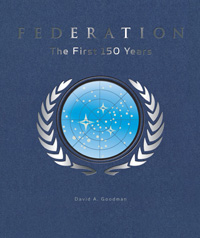
 TrekCore: That’s interesting, so did you find yourself anywhere in the project needing to turn to any previous Star Trek authors or staff who worked behind the scenes on the shows?
TrekCore: That’s interesting, so did you find yourself anywhere in the project needing to turn to any previous Star Trek authors or staff who worked behind the scenes on the shows?